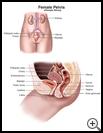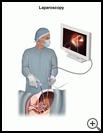
Uterus Removal by Laparoscopically Assisted Vaginal Hysterectomy
________________________________________________________________________
KEY POINTS
- A vaginal hysterectomy with laparoscopy is surgery that uses a lighted tube with a camera placed through a small cut near your belly button. This allows your healthcare provider to see organs. The uterus is removed through a cut in the vagina. You may have this surgery to treat fibroids, cancer, pelvic pain, or abnormal vaginal bleeding.
- Ask your healthcare provider how long it will take to recover and how to take care of yourself at home.
- Make sure you know what symptoms or problems you should watch for and what to do if you have them.
________________________________________________________________________
What is a laparoscopically assisted vaginal hysterectomy (LAVH)?
A vaginal hysterectomy is surgery to remove the uterus through the vagina. It is a way to take the uterus out through a cut in the vagina instead of through a cut in your belly. The ovaries or fallopian tubes (other female organs) may also be removed when the uterus is removed.
The uterus (womb) is the muscular organ at the top of the vagina. Babies grow in the uterus, and menstrual blood comes from the uterus. If you were having menstrual periods before the surgery, you will no longer have them after the operation. Without your uterus you will not be able to get pregnant.
When a vaginal hysterectomy is assisted with laparoscopy, your healthcare provider uses a tool called a laparoscope to help with the removal. A laparoscope is a lighted tube with a camera that is placed through a small cut near your belly button. This allows your healthcare provider to see organs. When laparoscopy is used, you will have only small cuts in your belly. This means you will probably have less pain after this operation than if your uterus was removed through a larger cut in your belly, and recovery is usually faster. Some healthcare providers may use a robot to help with this type of hysterectomy.
This procedure does not leave a large visible scar. You may have very small scars from the 2 or 3 tiny cuts in your belly that were used to place tools into your belly.
When is it used?
There are many reasons why your healthcare provider may recommend surgery to remove your uterus. Some of the problems that may be treated with a hysterectomy are:
- Abnormal vaginal bleeding that has not been controlled with other treatments
- Noncancerous growths in the uterus called fibroids
- Abnormal growth of uterine tissue outside the uterus (endometriosis)
- A uterus that has dropped down into the vagina and is causing a problem
- Precancerous or cancerous cells on the cervix (opening to the womb) or in the uterus
- Pelvic pain that has not been controlled with other treatments
Ask your healthcare provider about your choices for treatment and the risks.
How do I prepare for this procedure?
- Make plans for your care and recovery after you have the procedure. Find someone to give you a ride home after the procedure. Allow for time to rest and try to find other people to help with your day-to-day tasks while you recover.
- Follow your healthcare provider's instructions about not smoking before and after the procedure. Smokers may have more breathing problems during the procedure and heal more slowly. It is best to quit 6 to 8 weeks before surgery.
- You may or may not need to take your regular medicines the day of the procedure. Tell your healthcare provider about all medicines and supplements that you take. Some products may increase your risk of side effects. Ask your healthcare provider if you need to avoid taking any medicine or supplements before the procedure.
- Tell your healthcare provider if you have any food, medicine, or other allergies such as latex.
- Your healthcare provider will tell you when to stop eating and drinking before the procedure. This helps to keep you from vomiting during the procedure.
- Your healthcare provider may ask you to take an enema or medicine to clean out your bowel before the procedure.
- Follow any other instructions your healthcare provider gives you.
- Ask any questions you have before the procedure. You should understand what your healthcare provider is going to do. You have the right to make decisions about your healthcare and to give permission for any tests or procedures.
What happens during the procedure?
The procedure is usually done at the hospital.
You will be given a regional or general anesthetic to keep you from feeling pain. A regional anesthetic numbs the lower part of your body while you stay awake. General anesthesia relaxes your muscles and puts you into a deep sleep.
Your healthcare provider will make a small cut near your bellybutton. Your belly will be inflated with carbon dioxide gas. This helps your provider see your organs. Your healthcare provider will put a laparoscope through the cut. The scope is used to see the uterus and guide other tools through other small cuts in your belly. Your provider will make a cut in the vagina and remove the uterus through the vagina. The ovaries or fallopian tubes (other female organs) may also be removed. The laparoscope and other tools are then removed and the cuts in your belly are closed.
If ligaments and other tissue around the vagina have stretched from aging or childbearing, your provider may also repair the walls of the vagina. The top of the vagina is then sewn closed.
What happens after the procedure?
You may sometimes go home the same day as your surgery, or you may stay in the hospital for 1 to 3 days.
You may need to go home with a catheter in your bladder until your bladder is working normally again. Your healthcare provider will decide when the catheter can be removed during a follow-up visit.
You may have some pain, nausea, or vomiting right after the procedure. Your healthcare provider may give you medicine to help these problems.
Sometimes the gas used to inflate your belly will cause pain in your right shoulder. It usually goes away after a day or two of bed rest.
Eating fruits and vegetables and drinking extra fluids may help you avoid constipation. Constipation is common after surgery because of some medicines and inactivity. If diet and extra fluids are not enough to avoid constipation, your provider may recommend a stool softener or a laxative. Check with your healthcare provider if constipation keeps being a problem.
If your ovaries are removed, menopause will start right away if you haven’t already had menopause. Your healthcare provider may prescribe medicine, such as hormone therapy, to help relieve some of the symptoms of menopause. Be sure to discuss any concerns you have about these effects and treatments with your provider before the surgery.
Ask your healthcare provider:
- How long it will take to recover
- If there are activities you should avoid, including how much weight you can lift, and when you can return to your normal activities
- How to take care of yourself at home
- What symptoms or problems you should watch for and what to do if you have them
Make sure you know when you should come back for a checkup. Keep all appointments for provider visits or tests.
What are the risks of this procedure?
Every procedure or treatment has risks. Some possible risks of this procedure include:
- You may have problems with anesthesia.
- You may have infection, bleeding, or blood clots.
- Other parts of your body may be injured during the procedure.
Ask your healthcare provider how these risks apply to you. Be sure to discuss any other questions or concerns that you may have.


